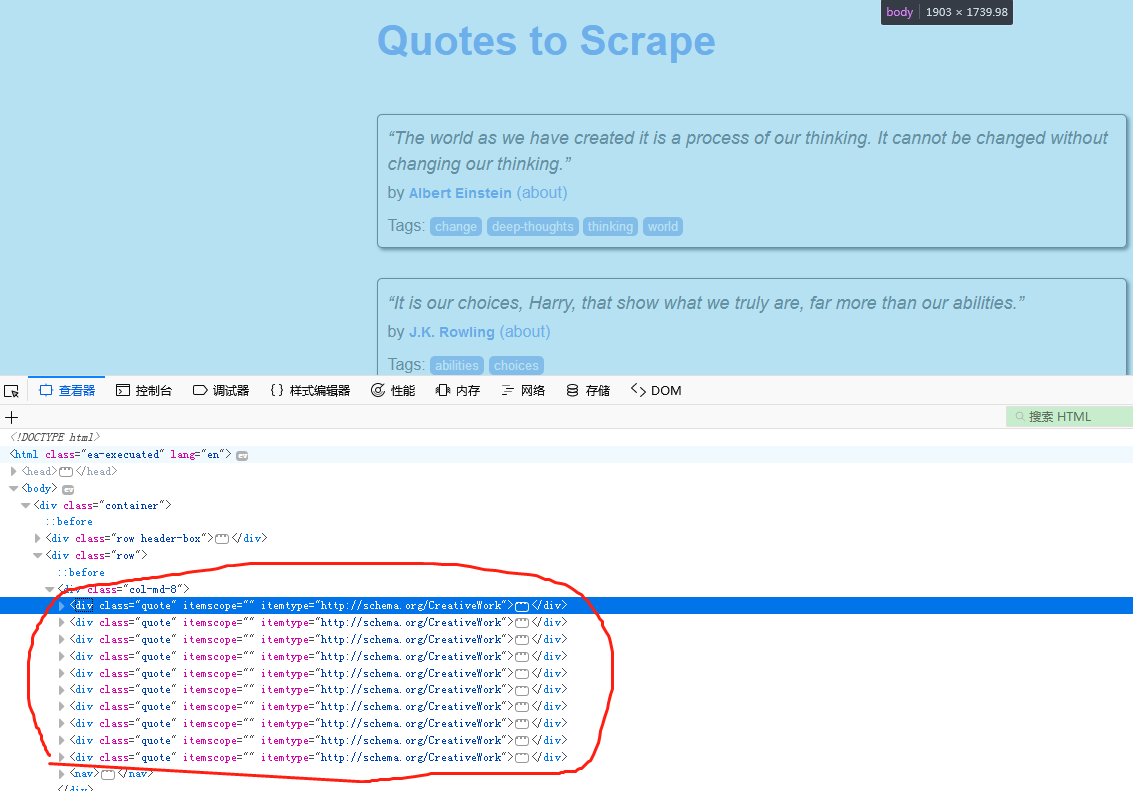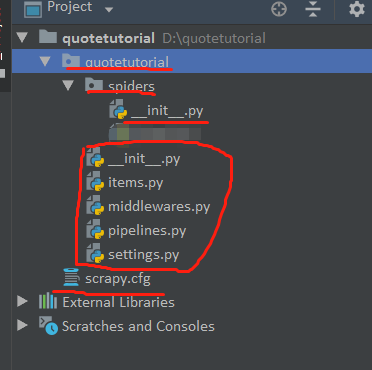需要学习的地方:
1.Scrapy框架流程梳理,各文件的用途等
2.在Scrapy框架中使用MongoDB数据库存储数据
3.提取下一页链接,回调自身函数再次获取数据
重点:从当前页获取下一页的链接,传给函数自身继续发起请求
next = response.css('.pager .next a::attr(href)').extract_first() # 获取下一页的相对链接
url = response.urljoin(next) # 生成完整的下一页链接
yield scrapy.Request(url=url, callback=self.parse) # 把下一页的链接回调给自身再次请求
站点:http://quotes.toscrape.com
该站点网页结构比较简单,需要的数据都在div标签中

操作步骤:
1.创建项目
# scrapy startproject quotetutorial
此时目录结构如下:

2.生成爬虫文件
# cd quotetutorial
# scrapy genspider quotes quotes.toscrape.com # 若是有多个爬虫多次操作该命令即可

3.编辑items.py文件,获取需要输出的数据
import scrapy
class QuoteItem(scrapy.Item):
# define the fields for your item here like:
# name = scrapy.Field()
text = scrapy.Field()
author = scrapy.Field()
tags = scrapy.Field()
4.编辑quotes.py文件,爬取网站数据
# -*- coding: utf-8 -*-
import scrapy
from quotetutorial.items import QuoteItem
class QuotesSpider(scrapy.Spider):
name = 'quotes'
allowed_domains = ['quotes.toscrape.com']
start_urls = ['http://quotes.toscrape.com/']
def parse(self, response):
# print(response.status) # 200
quotes = response.css('.quote')
for quote in quotes:
item = QuoteItem()
text = quote.css('.text::text').extract_first()
author = quote.css('.author::text').extract_first()
tags = quote.css('.tags .tag::text').extract()
item['text'] = text
item['author'] = author
item['tags'] = tags
yield item
next = response.css('.pager .next a::attr(href)').extract_first() # 获取下一页的相对链接
url = response.urljoin(next) # 生成完整的下一页链接
yield scrapy.Request(url=url, callback=self.parse) # 把下一页的链接回调给自身再次请求
5.编写pipelines.py文件,进一步处理item数据,保存到mongodb数据库
# -*- coding: utf-8 -*-
# Define your item pipelines here
#
# Don't forget to add your pipeline to the ITEM_PIPELINES setting
# See: https://doc.scrapy.org/en/latest/topics/item-pipeline.html
# 使用的话需要在settings文件中设置
import pymongo as pymongo
from scrapy.exceptions import DropItem
class TextPipeline(object):
"""对输出的item进行进一步的处理"""
def __init__(self):
self.limit = 50
def process_item(self, item, spider):
if item['text']:
if len(item['text']) > self.limit:
item['text'] = item['text'][0:self.limit].rstrip() + '......'
return item
else:
return DropItem('Missing Text!')
class MongoPipeline(object):
"""把输出的item保存到MongoDB数据库"""
def __init__(self, mongo_url, mongo_db):
self.mongo_uri = mongo_url
self.mongo_db = mongo_db
@classmethod
def from_crawler(cls, crawler):
"""从settings文件获取配置信息"""
return cls(
mongo_url=crawler.settings.get('MONGO_URI'),
mongo_db=crawler.settings.get('MONGO_DB')
)
def open_spider(self, spider):
"""初始化mongodb"""
self.client = pymongo.MongoClient(self.mongo_uri)
self.db = self.client[self.mongo_db] # 为啥用[],而不是()
def process_item(self, item, spider):
name = item.__class__.__name__ # 获取item的名称用作表名,也就是QuoteItem
self.db[name].insert(dict(item)) # 为啥要用dict(item)
return item
def close_spider(self, spider):
self.client.close()
6.编辑配置文件,增加mongodb数据库参数,以及使用的pipeline管道参数
ITEM_PIPELINES = {
# 'quotetutorial.pipelines.TextPipeline': 300,
'quotetutorial.pipelines.MongoPipeline': 400,
}
MONGO_URI = 'localhost'
MONGO_DB = 'quotestutorial'
7.执行程序
# scrapy crawl quotes
8.保存到文件
# scrapy crawl quotes -o quotes.json # 保存成json文件
# scrapy crawl quotes -o quotes.csv # 保存成csv文件
# scrapy crawl quotes -o quotes.xml # 保存成xml文件
# scrapy crawl quotes -o quotes.jl # 保存成jl文件
# scrapy crawl quotes -o quotes.pickle # 保存成pickle文件
# scrapy crawl quotes -o quotes.marshal # 保存成marshal文件
# scrapy crawl quotes -o ftp://user:password@ftp.example.com/path/quotes.csv # 生成csv文件保存到远程FTP上
效果:

源码下载地址:https://files.cnblogs.com/files/sanduzxcvbnm/quotetutorial.7z
来源:oschina
链接:https://my.oschina.net/u/4305692/blog/3670517